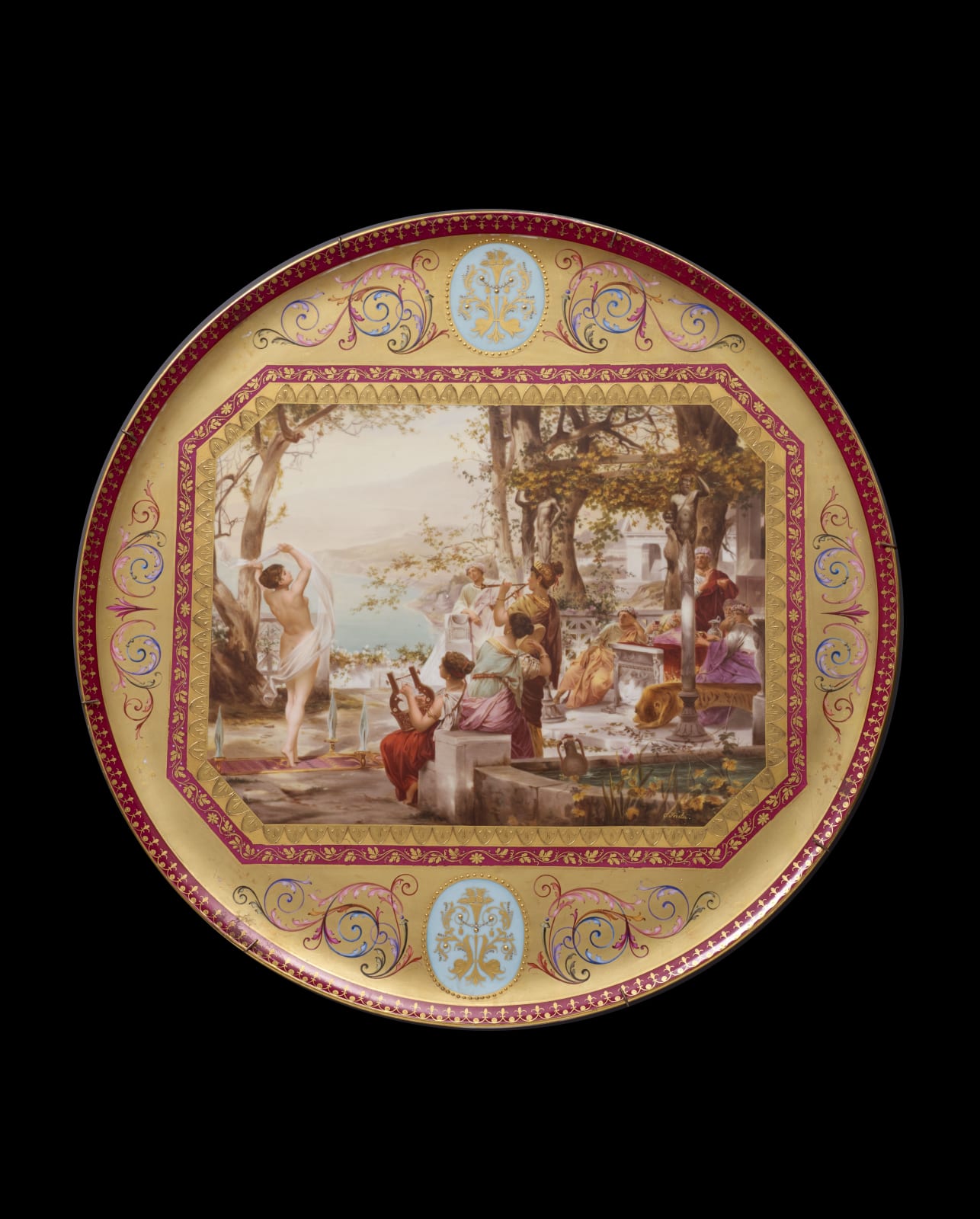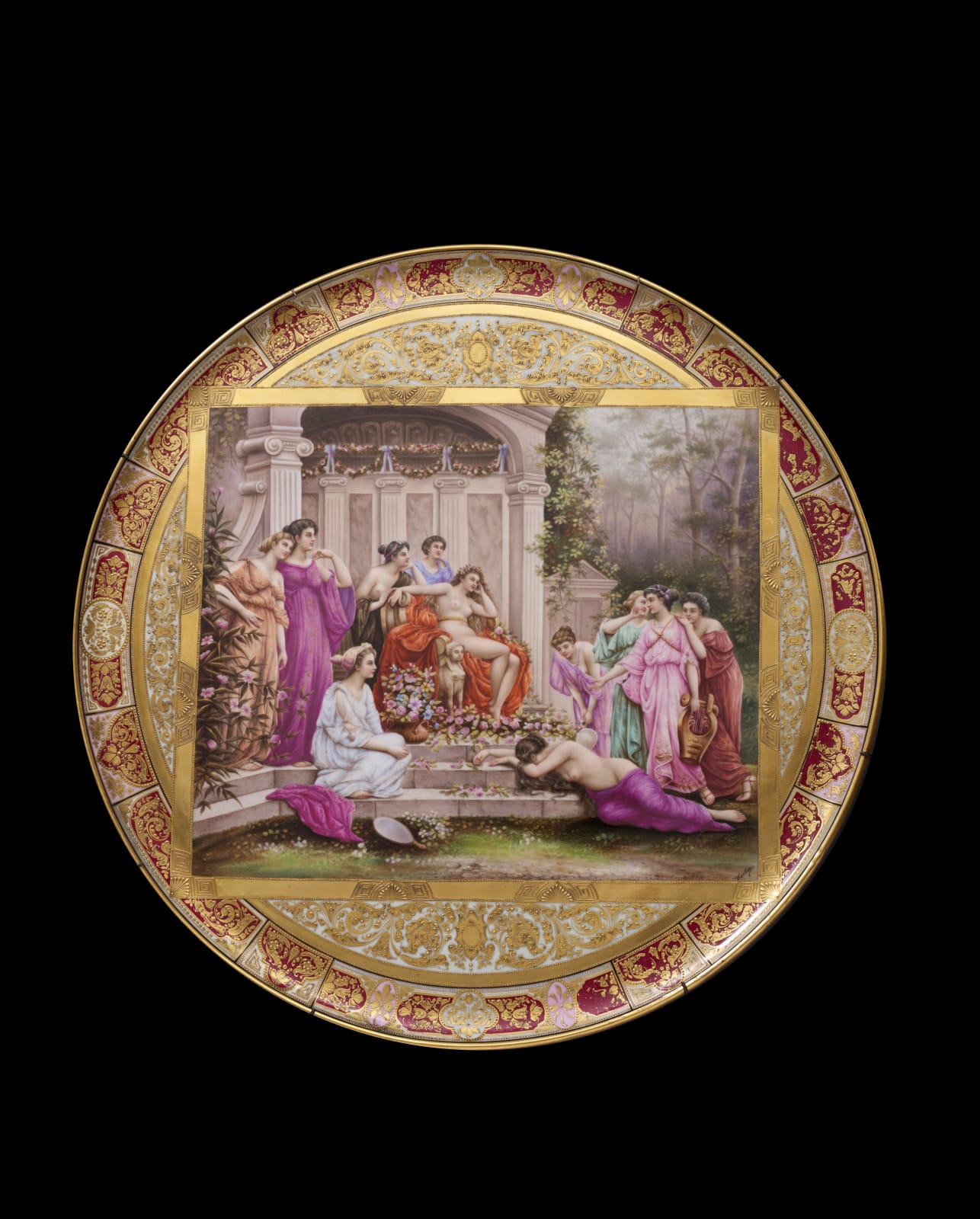C. Forster
A fine pair of Vienna style porcelain gold ground hand painted chargers, one signed C. Forster and titled in black verso “Der Schwertertanz” and bearing a blue beehive mark, impressed mark 0, the other and slightly larger charger signed Kantler and titled in black verso “Psyche vor Gericht” and also bearing a blue beehive mark, impressed mark S9. The first charger showing a scene after the painting “Der Schwertertanz” or “The Sword Dance” by Henryk Siemiradzki, set within a shaped rectangular gilt and claret frame with a gilt beaded and claret-ground surround, reserved by two oval panels of gilt floral and foliate arabesques on a turquoise ground, among polychrome scrollwork with an outer gilt and claret border. The other charger titled “Psyche vor Gericht” showing a scene after the painting “Psyche before the Throne of Venus” by Henrietta Rae, set within a rectangular gilt frame on a gilt arabesque ground, with an outer claret and gilt panelled border
Vienna, date circa 1895-1900
The platter showing “Der Schwertertanz” diameter 49 cm,
the platter showing “Psyche vor Gericht” diameter 49.5 cm.
These high quality hand painted chargers are very similar in style to those produced by the famous Vienna Porcelain factory which was founded in 1719 and eventually closed in 1864. Unfortunately little is known of the porcelain painter Kantler who was a highly accomplished artist and is known to have decorated a number of other late nineteenth and early twentieth century Vienna style porcelain plates, vases and jugs with narrative scenes as well as portraits. Among them is a handsome vase inscribed on the base “Festgesang” in the Benton County Historical Society Museum, Oregon, which features a beautifully painted classical maiden playing a harp within a central panel upon a bold foliate ground. Likewise C. Forster was an artist of the utmost skill whose signature appears on a number of similar chargers or decorative plates. As here many feature a central framed painting after a well known classical work including one after Angelica Kauffman’s painting of “Telemach und Mentor”.
The first charger, decorated by Forster, replicates a famous painting Henryk Siemiradzki (1843-1902), known as “Der Schwertertanz” or “The Sword Dance” but omits the extreme right and left hand sides of the original. Siemiradzki was one of the leading Polish painters of his day whose Greco-Roman and religious works were often collected by the Russian Imperial family and particularly by Tsarina Alexandra Feodorovna. “Der Schwertertanz” is one Siemiradzki’s best known works, of which he executed at least four versions. His earliest, probably completed in 1878, was acquired by Count Alexander Orlovsky. In 1881 the renowned Moscow merchant and collector K.T. Soldatenkov commissioned a copy which in 1925 was acquired by the Rumantsev Museum and later by the Tretyakov State Gallery, Moscow, where it can be seen today. The artist also painted another version in 1887 which was owned by the wealthy New York art collector Francis O. Matthiessen and sold the year after his death at the American Art Galleries, New York, April 1-2, 1902. In addition Siemiradzki executed a fourth and smaller version in 1898, which is now owned by a private Polish collector. Forster may have based his own painting on one of those versions, alternatively on one of the many engravings after the original or even copies by Siemiradzki’s contemporaries.
Siemiradzki’s scene is set against an idyllic Italian backdrop and takes its inspiration from Antiquity; the main figure may represent a hetaera, or sophisticated escort who danced for paying male guests. She also recalls a dancer depicted on an ancient fresco found near Pompeii: “Participants in the Mysteries and a Dancing Girl”, of which Siemiradzki may have seen a reproduction since the original was not fully excavated until after his death. At the same time the composition evokes a scene from the ballet Don Quixote in which a dancer moves along a narrow carpet lined by spear-bearing toreadors.
Siemiradzki, who was the son of a military physician, was born in the village of Novobelgorod (now Pechenegi) near Kharkov. His early art classes began at Kharkov Gymnasium where he studied under Karl Briullov and D. I. Besperchy. He then entered the Physics-Mathematics School at Kharkov University but continued studying painting under Besperchy. After graduating from the university, Siemiradzki abandoned science as a career and from 1864-70 studied at the Imperial Academy of Arts, Saint Petersburg, gaining a gold medal upon his graduation. From 1870-1871 he studied under Karl von Piloty in Munich and then moved to Rome, while spending summers at his estate in Strzałkowo, near Częstochowa in Poland. In 1873 he became an Academician of the Imperial Academy of Arts for his painting “Christ and a Sinner” based on a verse by Aleksey Konstantinovich Tolstoy. From then on he continued to paint religious and historical paintings as well as those inspired by Antiquity such as his monumental multi-figural composition “Pochodnie Nerona” (Nero’s Torches), painted 1876 (Polish National Museum in Kraków). He also executed two large paintings for the State Historical Museum, Moscow as well as a number of theatrical stage sets. After Siemiradzki’s death in 1902 at Strzałkowo, he was buried in Warsaw but his remains were later moved to the National Pantheone on Skałka in Kraków.
Like Forster’s rendition after Siemiradzki’s acclaimed work, Kantler’s exquisite depiction in the second charger is taken from another famous painting by the acclaimed British artist Henrietta Rae (1859-1928) - “Psyche Before the Throne of Venus”, an extremely large oil (measuring 6 x 10 feet; 183 x 305 cm), which was exhibited at the Royal Academy London in 1894. Since Henrietta Rae’s original painting is now untraced and is only known from contemporary photogravures as well as by a preliminary sketch (now owned by Northumbria University Gallery, Northumberland), Kantler’s rendition on the present charger is of significant importance. However for the purposes of replicating the scene within a circular plate Kantler had to reduce the painting’s length and thus omits a small group of maidens to the right of the temple, thus bringing Psyche closer to Venus’s throne.
“Psyche Before the Throne of Venus” depicts Psyche lying prostrate before Venus who sits in judgement. The young and beautiful maiden of Greek mythology fell in love with Venus’s son Cupid who used to visit her nightly but insisted that she was not allowed to know his identity. However one night Psyche disobeyed him and held a lamp up so that she could see her lover. On discovering this Cupid abandoned her and Psyche was left distraught. She was then found by Venus’s hand maidens and taken in chains before the throne of the goddess. Venus was enraged by Psyche’s ill-treatment of her son, and the inconsolable girl was thrown at her feet to plead for mercy whilst the Goddess of Love glares down from her throne above. Psyche then became Venus’s slave and was set a series of seemingly impossible tasks which she managed to complete and was finally forgiven by Venus.
Henrietta Rae was inspired to paint the scene after re-reading William Morris’s “Earthly Paradise” (1868-70) which included an account of Psyche’s story. In 1892 Rae began painting “Psyche Before the Throne of Venus” at her studio in Holland Park, close to that of her friend and mentor Sir Frederic Leighton PRA, who gave Rae much encouragement and criticism regarding the picture as it developed. Since the painting was so large it soon became clear that her small studio could not accommodate it so she was lent a larger studio belonging to another great British artist Sir William Blake Richmond. She later took a studio at Norwood in south London and continued to work upon the painting, eventually finishing it in 1894, in time for it to be exhibited at the Royal Academy exhibition of 1894. When shown to the public it received mixed reviews but was bought for the prestigious collection of the wealthy Scottish mining engineer and connoisseur George McCulloch.
Like Siemiradzki, Henrietta Rae enjoyed an illustrious career and was known for her classical works as well as her ability to depict the nude. Born in Hammersmith near London on 30th December 1859, she was educated at various artistic establishments including the Female School of Art, Heatherleys and from 1877 at the Royal Academy schools. She first exhibited at the Academy in 1881 and soon attracted considerable attention. In 1884 she married Ernest Normand (1857-1923), who was also a well-known artist. After their marriage they lived in Holland Park, Kensington, close to Sir Frederic Leighton. Then in 1890 they spent time in Paris, where Henrietta studied at the Académie Julien, which, unusually allowed women students to study from life and gave her the confidence and ability to depict graceful and poetic nudes, of which “Psyche Before the Throne of Venus” was her tour de force.



